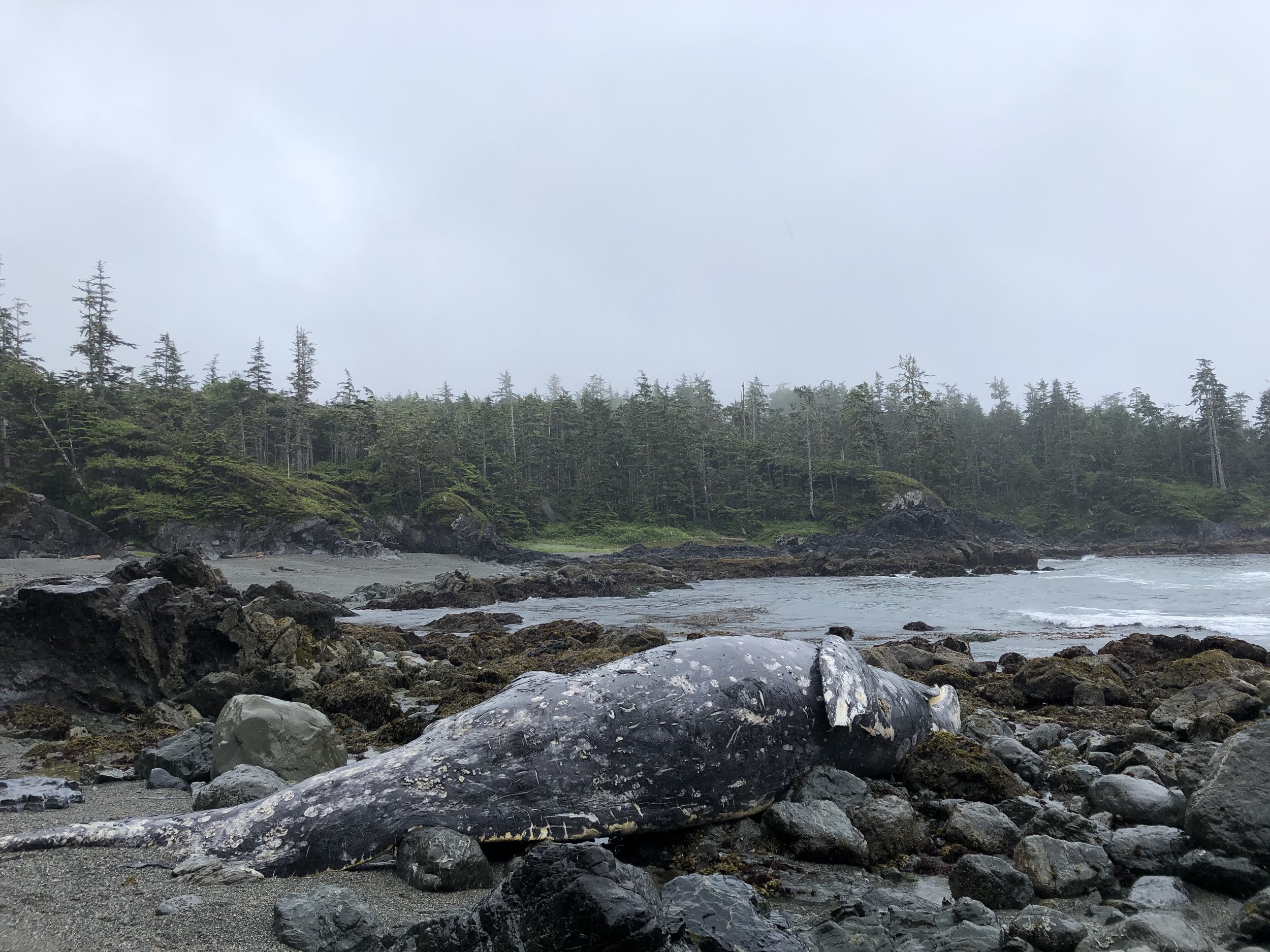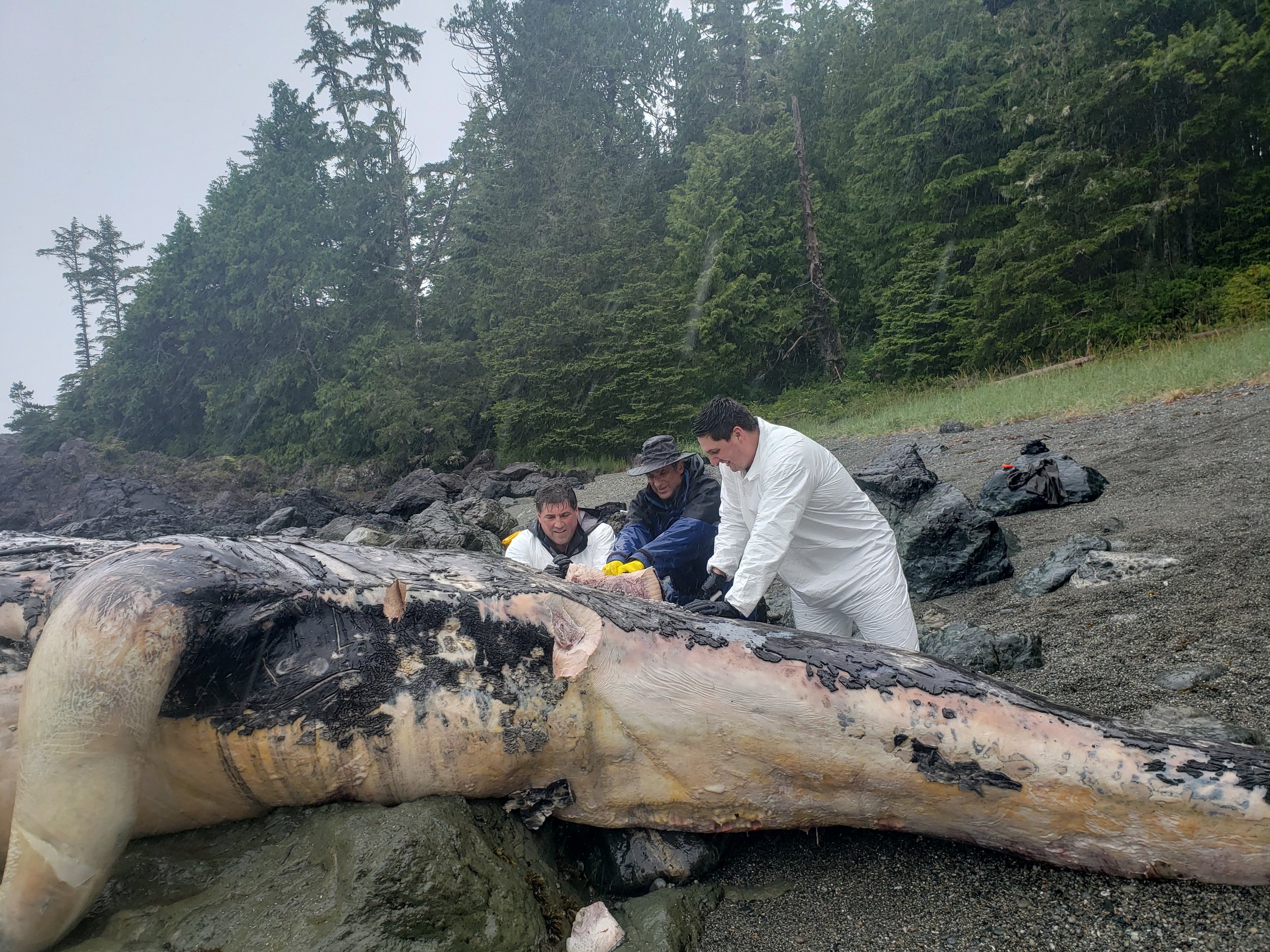Large Losses…The Unusual Gray Whale Mortality Event
/The day was July 11th, 2020, when our Executive Director Karyssa Arnett walked onto a sad and smelly scene. A 45 foot long Gray whale lay dead, washed up on the rocky shore near Ucluelet, British Columbia. Our team at Strawberry Isle Marine Research Society is part of the British Columbia Marine Mammal Response Network (BCMMRN), with authorization from the DFO, we respond to marine mammal incidences like entanglements, vessel strikes, and necropsies along our coastline. On this day, Karyssa, with a team of other experts, conducted one of the largest necropsies of her life. Collecting information about how this magnificent animal may have died and its body condition before it did. You can read more about their impressive undertaking in our Scuttlebutt blog “Elbow Deep in a Gray Whale”.
It turns out that this gray whale stranding she attended was just one of 172 strandings that had happened that year along the coasts of Canada, the U.S. and Mexico (NOAA). A number six times higher than the 18 year average (of 29 strandings per year). The phenomenon of increased gray whale strandings was first put on researchers' radars in 2019. A year that saw more than 216 gray whale strandings from Alaska to Mexico (NOAA).
Now, what exactly is a “stranding”? It’s when a whale is discovered deceased, often washing up on the shore. These numbers reflect the whales that were found, but there potentially could be many more that sank to the bottom of the sea floor or were scavenged by other animals.
So, how bad was it?
The U.S. National Marine Fisheries Service deemed it an Unusual Mortality Event (UME), under the Marine Mammal Protection Act. A name given when strandings are unexpected, involve a significant amount of die-off in a marine mammal population, and demand an immediate response (NOAA). This UME designation helps with the urgency of understanding and investigating the situation, since mass die-offs can often be an indicator of larger issues at hand in regards to ocean health and environmental factors.
You’re probably wondering, “Why were they dying? There must be an explanation…”. Well, like most of the time in science and research, there are a few theories. It’s important to begin by telling you that this is not the first time this has happened. Let’s rewind the clock to the years 1999 and 2000, when 651 dead gray whales were reported, and a UME was declared for Gray Whales on the west coast of North America. The strandings lasted two years and occurred during the whales northbound migration. This previous incident gave researchers an insight into the potential timeline and scale for the recent UME that began in 2019. There was also a UME case in 2015-2016 for large whales such as fin and humpbacks in the Western Gulf of Alaska and British Columbia.
So, we know that gray whale UME’s have been occurring on and off for years and have even occurred for other whale species.
But why?
One theory suggests that Gray whales may suffer from limited food supplies when preparing for their migration and breeding seasons. Gray whales have one of the longest migration routes of all animals, traveling 15,000-20,000 km from Alaska to Baja California and back. They don’t feed much when they’re on the move or once they’ve arrived in Mexico, since they are busy breeding and rearing their young. If they don’t “bulk up” enough during their summer feeding season to sustain them for the next six months, they’re in trouble. Many strandings have occured in the spring as the whales make their way north, a large amount of which were found emaciated. This points to Gray whales being too weak to make the journey back to their feeding grounds for the summer.
Other strandings have shown evidence of vessel strikes, perhaps pointing to increased boating traffic as a cause. Another theory involves the effect of underwater noise. It may be the case that noise from boats and human activities in the water cause the whales to become disoriented or isolated from their group as their communication is disrupted. The idea is that Gray whales lose track of where they are on the coast and find themselves trapped or too close to the shore as the tide goes out. Other theories involve unknown diseases, or the impact of increased radio frequency noise generated by solar storms. Perhaps, it may be a combination of these theories that are causing UME’s. However, more research is needed to uncover the troubling pattern that is emerging.
Our connection with Gray whales on the west coast is undeniably strong. The Nuu-chah-nulth have held a deeply spiritual connection with Ciciłn̓ii (Gray whales) for thousands of years, as an important resource for food and trade. Over the years, our emerging communities in Tofino and Ucluelet have formed meaningful connections with some of the local visitors, including; Scarface, who frequents Long beach in the spring; Orange Crush, first seen in 1977 with orange whale lice; Admiral, with his distinct propeller scars, and many more of our favorites who frequent these waters.
We owe these whales a thank you for bolstering our economy here in Tofino and Ucluelet, as whale tours gaze on their grandeur from afar. We can watch as they scoop up the sandy bottom of Clayoquot Sound, sifting through it with their baleen and licking off the tiny critters. Their irony will always fascinate us, being one of the largest animals on earth yet feeding on some of the smallest creatures in the sea! Next time you see a blow, remember we still have a lot to learn and there’s more to the Gray whale than what’s on the surface.
Written by Amanda Purnell, Amanda is the new Oceanwise Direct Action Ambassador at SIMRS.





